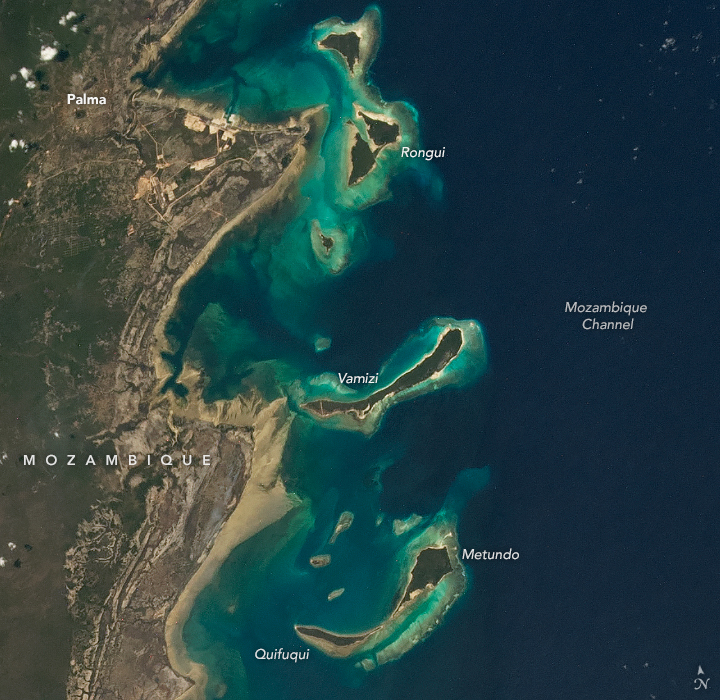November 24, 2021
The Quirimbas Islands stretch 322 kilometers (200 miles) along Mozambique’s coastline and are teeming with an impressive array of plants and animals.
The 32 small islands that make up the archipelago are partly linked to the coast by mangroves, sand bars, and coral reefs.
An astronaut on the International Space Station took this photograph of the northern part of the Quirimbas Islands, near the Tanzania border, on November 24, 2021.
Light blue-green water highlights the shallow complex of corals, sand, and seagrass surrounding the islands.
A map of the island in 1775
Après de Mannevillette, Jean-Baptiste-Nicolas-Denis d' (1707-1780)
Bibliothèque nationale de France
In 2018, the United Nations Educational, Scientific and Cultural Organization (UNESCO) selected the islands to be protected as one of its 738 biosphere reserves because of its unique biodiversity.
According to UNESCO, the islands are home to 3,000 floral species, of which 1,000 are endemic, meaning they are only found on the islands.
The islands’ waters host 52 species of corals, 140 species of mollusk, and eight species of marine mammals including whales and dolphins.
Five species of sea turtles are found there: loggerhead turtle (Caretta caretta), green turtle (Chelonia midas), leatherback turtle (Dermochelys coriacea), hawksbill turtle (Eretmochelys imbricata) and olive ridley (Lepidochelys olivacea).
All five of these species are listed by the International Union for Conservation of Nature as being threatened with extinction.

November 24, 2021
Vamizi, the long crescent-shaped island centered in the image above, is one of the largest islands of the Quirimbas Archipelago.
The island is an important nesting site for hawksbill turtles and green turtles.
Some 170 green turtle nests were observed on the island during 2019 and 2020, making it the species’ largest nesting site in Mozambique.
Increased tourism and fishing on and around Vamizi island in recent years has put pressure on the island’s marine ecosystem.
Certain fishing methods are hazardous to sea turtles, which can get accidentally caught in nets and tangled in fishing gear.
The island is an important nesting site for hawksbill turtles and green turtles.
Some 170 green turtle nests were observed on the island during 2019 and 2020, making it the species’ largest nesting site in Mozambique.
Increased tourism and fishing on and around Vamizi island in recent years has put pressure on the island’s marine ecosystem.
Certain fishing methods are hazardous to sea turtles, which can get accidentally caught in nets and tangled in fishing gear.
Quirimbas Archipelago along the coast of Northern Mozambique shown here in layers: #Sentinel2 Image composite, Nautical Chart, and 10-meter resolution #SatelliteDerivedBathymetry. #hydrospatial https://t.co/eMQRIJFLVj pic.twitter.com/FKIPoN4ZEs
— TCarta (@TCarta_) November 5, 2022
Concern about the health of marine species near the island led to the creation of Community Fishers’ Council (the Conselho Comunitário de Pesca), which established the Vamizi Community Sanctuary on the western side of the island as a no-fish zone.
Links :
- Oceans withour borders : Quirimbas Archipelago Hope Spot




No comments:
Post a Comment